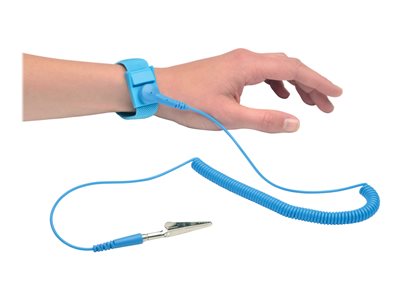An antistatic wrist strap is an essential tool for anyone working with sensitive electronic equipment. It is designed to prevent the buildup of static electricity on the body of the person wearing it, which can cause electrostatic discharge (ESD) and damage the equipment they are working on. In this article, we will explore the benefits and uses of antistatic wrist straps.
The purpose of an antistatic wrist strap is to provide a path to the ground for any static electricity that may build up on the body of the person wearing it. This is achieved by connecting the wrist strap to an electrical ground line, such as an electrical outlet or a metal object that is grounded. By doing so, any static electricity that builds up on the body of the person wearing the wrist strap is safely discharged to the ground, rather than being discharged into the sensitive electronic equipment they are working on.
Antistatic wrist straps are particularly important for those working with ESD-sensitive components, such as computer chips, circuit boards, and other electronic equipment. These components are highly sensitive to even small amounts of static electricity, which can cause damage or even complete failure. By wearing an antistatic wrist strap, workers can ensure that they are not inadvertently causing damage to the equipment they are working on.
There are several types of antistatic wrist straps available, including wireless wrist straps and traditional wired wrist straps. While wireless wrist straps may seem like a convenient option, testing has shown that they are not as effective as wired wrist straps in preventing charge buildup and discharging static electricity. As such, it is recommended that workers use a traditional wired wrist strap for maximum effectiveness.
When using an antistatic wrist strap, it is important to ensure that it is properly connected to an electrical ground line. This can be done by plugging the wrist strap into an electrical outlet or clipping it onto the free-standing ground, such as a metal table or chair leg. Additionally, it is important to wear the wrist strap snugly against the skin, as any gaps between the skin and the strap can prevent it from working effectively.
Antistatic wrist straps are an essential tool for anyone working with sensitive electronic equipment. By providing a path to ground for static electricity, they help prevent electrostatic discharge and protect valuable equipment from damage. While there are several types of wrist straps available, traditional wired wrist straps are the most effective and should be used whenever possible. So if you’re working with sensitive electronic equipment, be sure to invest in an antistatic wrist strap and protect your equipment from damage.

The Effectiveness of Anti-Static Wrist Straps
Based on the results of testing conducted by the NASA Interagency Working Group on Electrostatic Discharge (IAWG-ESD), it has been confirmed that wireless wrist straps are not effective in preventing charge buildup or draining accumulated charge to prevent potential discharges. While anti-static wrist straps are designed to prevent static electricity from building up on the human body, wireless wrist straps specifically have been found to be ineffective in achieving this goal. Therefore, if you are looking for a solution to prevent static electricity buildup, it may be necessary to explore other options beyond wireless wrist straps. Some alternatives that have been found to be effective in preventing static electricity buildup include:
– Wired anti-static wrist straps
– Conductive shoes or heel straps
– Conductive flooring or floor mats
– Grounding mats or workstations
It is important to note that the effectiveness of any anti-static solution will depend on several factors, including the specific environment in which it is being used and the individual wearing the device. Therefore, it may be necessary to experiment with different solutions to find the one that works best for your specific needs.
The Benefits of Using an Anti-Static Wrist Wrap
An anti-static wrist wrap is a device that is used to prevent static electricity from building up on an operator’s body while working with electronic components that are sensitive to electrostatic discharge (ESD). The device is designed to be worn on the wrist, and it is typically made from a conductive material that allows a path to the ground to be established. When the wrist wrap is properly grounded, any static electricity that is present on the operator’s body will be safely dissipated, preventing it from damaging sensitive electronic components. Some of the key benefits of using an anti-static wrist wrap include preventing damage to electronic components, improving overall product quality, and reducing the risk of injury to the operator. Additionally, wrist wraps can be used in a variety of industries, including electronics manufacturing, telecommunications, and aerospace, among others.

The Benefits of Using an Anti-Static Wrist Strap
An antistatic wrist strap, also known as an ESD wrist strap or ground bracelet, is a crucial tool for individuals working with very sensitive electronic equipment. The reason for this is that during the course of working with electronic equipment, a person’s body can accumulate static electricity, which can result in ESD – or electrostatic discharge.
ESD is a significant problem in the electronics industry, as it can cause irreparable damage to sensitive components and devices. The slightest static shock can potentially destroy or damage electronic components, resulting in costly repairs or replacements.
Wearing an antistatic wrist strap is an effective way to prevent the buildup of static electricity on the body. The wrist strap typically has a conductive wire that connects to a grounding point, which helps to safely discharge any static electricity that may have accumulated on the individual’s body. This ensures that the sensitive electronic equipment remains protected from ESD, and helps to prevent costly damage or repairs.
The use of an antistatic wrist strap is essential for individuals working with sensitive electronic equipment to prevent the buildup of static electricity on the body, which can result in ESD and potentially damage or destroy expensive electronic components.
Attaching an Anti-Static Wrist Strap
An anti-static wrist strap can be attached to an electrical ground line using an electrical outlet. Alternatively, it can be attached to free-standing grounds, such as a metal table on a stone floor. The key is to ensure that the wrist strap is securely attached to a ground source to effectively discharge any static electricity that may be present in the body. It is important to note that the wrist strap should be used in conjunction with other anti-static measures, such as a grounded work surface and proper handling of sensitive electronic components, to prevent damage from electrostatic discharge.
Conclusion
An anti-static wrist strap is an essential tool for anyone working with ESD-sensitive components. It provides a safe path to the ground and prevents the buildup of static electricity on the body, which can cause damage to sensitive equipment. While wireless wrist straps may seem like a convenient option, they have been proven to be ineffective in preventing charge buildup and discharges. Therefore, it is recommended to use a reliable and properly grounded antistatic wrist strap for maximum protection. Investing in a high-quality wrist strap can save time and money by avoiding costly repairs or replacements due to ESD damage. It is important to use and maintain these devices correctly to ensure their effectiveness and to promote a safe working environment.








